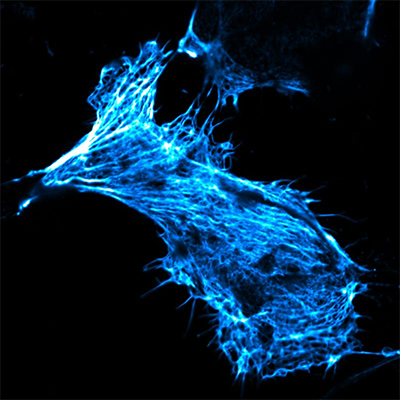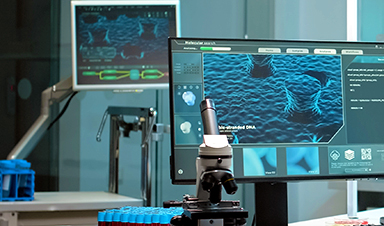| A research team headed by chemist Prof Bart Jan Ravoo and biochemist Prof Volker Gerke has designed nanocontainers made of sugar and protein components. These containers are taken up by cells through natural processes and can thereby transport substances that normally cannot penetrate the cell membrane – such as drugs or labelled substances for the investigation of cell functions – into cells. | |
| The study was published in Advanced Science (“Biodegradable and Dual-Responsive Polypeptide-Shelled Cyclodextrin-Containers for Intracellular Delivery of Membrane-Impermeable Cargo”). | |
 |
|
| Living human cancer cell in cell culture, its actin skeleton stained with fluorescent phalloidin. This toxic substance was only able to enter the cell by means of the newly developed nanocontainers. (Image: Kudruk & Pottanam Chali et al./Adv Sci 2021 (modified colours)) | |
| Nanocontainers can transport substances into cells where they can then take effect. This is the method used in, for example, the mRNA vaccines currently being employed against Covid-19 as well as certain cancer drugs. In research, similar transporters can also be used to deliver labelled substances into cells in order to study basic cellular functions. | |
| To take advantage of their full potential, scientists are conducting intensive research into how nanocontainers interact with biological environments and how they have to be chemically constructed to deliver cargo into cells in the gentlest and most controllable way possible. | |
| Scientists at the University of Münster have recently developed a new type of nanocontainer that is constructed entirely from biological components. Unlike other cargo transporters, these are not based on lipids but on sugar compounds which are sealed with a shell of protein structures – so-called polypeptides – the thickness of which is precisely tailored. | |
| “We do produce the components of our nanocontainers synthetically, but they are taken up by cells and – due to the overall structure we have developed – also degraded by them just like naturally occurring substances,” explains chemist Prof Bart Jan Ravoo. | |
| “For the degradation of the container shell inside the cell, we make use of two naturally occurring mechanisms – as a result, the transported substances are released rapidly, as soon as they arrive in the cell,” adds biochemist Prof Volker Gerke. | |
| The scientists want to use the tiny nanocontainers, which are about 150 nanometers in diameter, to load cells with labelled biologically relevant lipids that can be used to study transport processes occurring within the cell membrane. In addition, they plan to further develop the chemical design of the containers in such a way that they are, for example, only taken up by certain types of cells or only release their cargo when stimulated by external light. | |
| In the future, transport systems built from sugar and protein components might also be suitable for applications in living organisms to deliver drugs specifically into certain tissues and cells. | |
| Details on methods and results: | |
Bioinspired materials organize themselves, forming cargo-carrying containers |
|
| To synthesize the new cargo transporters, the scientists used sugar compounds (modified cyclodextrins) that are similar in structure – and thus behaviour – to certain lipids naturally found in every cell. Similar to the protective cell membrane lipids, the sugar structures arrange themselves, forming a shell in which they enclose the substances to be transported. However, because the resulting container is still leaky and would lose its cargo over time, the scientists added protein structures (polypeptides) that form a sealing layer around the container. | |
| “To test how thick the sealing layer needed to be, we varied the length of the peptide sequences and tailored them so that the containers stably encapsulated their cargo,” explains Sharafudheen Pottanam Chali, a chemistry doctoral student and one of the study’s two lead authors. | |
Nanocontainers that use a natural pathway into cells |
|
| In the next step, the scientists investigated whether and how the newly developed nanocontainers were taken up by cells. Their hypothesis was that this happens via so-called endocytosis. In this process, the cells internalize a part of their cell membrane and pinch it off, creating small vesicles called endosomes in which extracellular material is transported into the cell. To test this, the scientists used a sugar compound (dextran) known to be taken up by endocytosis. They treated their cell cultures with red fluorescent dextran and, at the same time, added nanocontainers filled with a green fluorescent cargo (pyranine). | |
| “In the fluorescence microscope, it became visible that both substances were taken up into the cells equally and their fluorescence overlapped visibly – therefore we could conclude that the nanocontainers, just like the dextran, were efficiently taken up by the cells through the endosomal transport process,” explains Sergej Kudruk, a biochemistry doctoral student and also a lead author of the study. | |
| The scientists confirmed this for two different cell types – human blood vessel cells and cancer cells. | |
Container shell is degraded by enzymes in the cells’ endosomes |
|
| Conditions inside the endosomes differ from those of the cellular environment, something which the scientists already were considering when designing their nanocontainers. They constructed the containers in such a way that the altered environment in the endosomes destabilizes and partially degrades the polypeptide shell – the nanocontainers thus become leaky and release their cargo into the inside of the cell. | |
| “When the containers are taken up into endosomes, two types of enzymes, which we knew to be present in endosomes and which can contribute to the degradation of the shell at specific sites, come into play,” explains Sergej Kudruk. | |
| “So-called reductases degrade the disulfide bridges that were previously established to crosslink the peptide molecules of our nanocontainers – in addition, peptidases cleave the peptide molecules themselves,” adds Sharafudheen Pottanam Chali. | |
| The scientists also tested the degradability of the container shell outside the cell. To do so, they loaded the containers with a fluorescent dye and simulated part of the complex endosomal microenvironment by using the enzyme trypsin as well as reducing agents. After treatment, the dye leaked out immediately. |
News
AI matches doctors in mapping lung tumors for radiation therapy
In radiation therapy, precision can save lives. Oncologists must carefully map the size and location of a tumor before delivering high-dose radiation to destroy cancer cells while sparing healthy tissue. But this process, called [...]
Scientists Finally “See” Key Protein That Controls Inflammation
Researchers used advanced microscopy to uncover important protein structures. For the first time, two important protein structures in the human body are being visualized, thanks in part to cutting-edge technology at the University of [...]
AI tool detects 9 types of dementia from a single brain scan
Mayo Clinic researchers have developed a new artificial intelligence (AI) tool that helps clinicians identify brain activity patterns linked to nine types of dementia, including Alzheimer's disease, using a single, widely available scan—a transformative [...]
Is plastic packaging putting more than just food on your plate?
New research reveals that common food packaging and utensils can shed microscopic plastics into our food, prompting urgent calls for stricter testing and updated regulations to protect public health. Beyond microplastics: The analysis intentionally [...]
Aging Spreads Through the Bloodstream
Summary: New research reveals that aging isn’t just a local cellular process—it can spread throughout the body via the bloodstream. A redox-sensitive protein called ReHMGB1, secreted by senescent cells, was found to trigger aging features [...]
AI and nanomedicine find rare biomarkers for prostrate cancer and atherosclerosis
Imagine a stadium packed with 75,000 fans, all wearing green and white jerseys—except one person in a solid green shirt. Finding that person would be tough. That's how hard it is for scientists to [...]
Are Pesticides Breeding the Next Pandemic? Experts Warn of Fungal Superbugs
Fungicides used in agriculture have been linked to an increase in resistance to antifungal drugs in both humans and animals. Fungal infections are on the rise, and two UC Davis infectious disease experts, Dr. George Thompson [...]
Scientists Crack the 500-Million-Year-Old Code That Controls Your Immune System
A collaborative team from Penn Medicine and Penn Engineering has uncovered the mathematical principles behind a 500-million-year-old protein network that determines whether foreign materials are recognized as friend or foe. How does your body [...]
Team discovers how tiny parts of cells stay organized, new insights for blocking cancer growth
A team of international researchers led by scientists at City of Hope provides the most thorough account yet of an elusive target for cancer treatment. Published in Science Advances, the study suggests a complex signaling [...]
Nanomaterials in Ophthalmology: A Review
Eye diseases are becoming more common. In 2020, over 250 million people had mild vision problems, and 295 million experienced moderate to severe ocular conditions. In response, researchers are turning to nanotechnology and nanomaterials—tools that are transforming [...]
Natural Plant Extract Removes up to 90% of Microplastics From Water
Researchers found that natural polymers derived from okra and fenugreek are highly effective at removing microplastics from water. The same sticky substances that make okra slimy and give fenugreek its gel-like texture could help [...]
Instant coffee may damage your eyes, genetic study finds
A new genetic study shows that just one extra cup of instant coffee a day could significantly increase your risk of developing dry AMD, shedding fresh light on how our daily beverage choices may [...]
Nanoneedle patch offers painless alternative to traditional cancer biopsies
A patch containing tens of millions of microscopic nanoneedles could soon replace traditional biopsies, scientists have found. The patch offers a painless and less invasive alternative for millions of patients worldwide who undergo biopsies [...]
Small antibodies provide broad protection against SARS coronaviruses
Scientists have discovered a unique class of small antibodies that are strongly protective against a wide range of SARS coronaviruses, including SARS-CoV-1 and numerous early and recent SARS-CoV-2 variants. The unique antibodies target an [...]
Controlling This One Molecule Could Halt Alzheimer’s in Its Tracks
New research identifies the immune molecule STING as a driver of brain damage in Alzheimer’s. A new approach to Alzheimer’s disease has led to an exciting discovery that could help stop the devastating cognitive decline [...]
Cyborg tadpoles are helping us learn how brain development starts
How does our brain, which is capable of generating complex thoughts, actions and even self-reflection, grow out of essentially nothing? An experiment in tadpoles, in which an electronic implant was incorporated into a precursor [...]






















